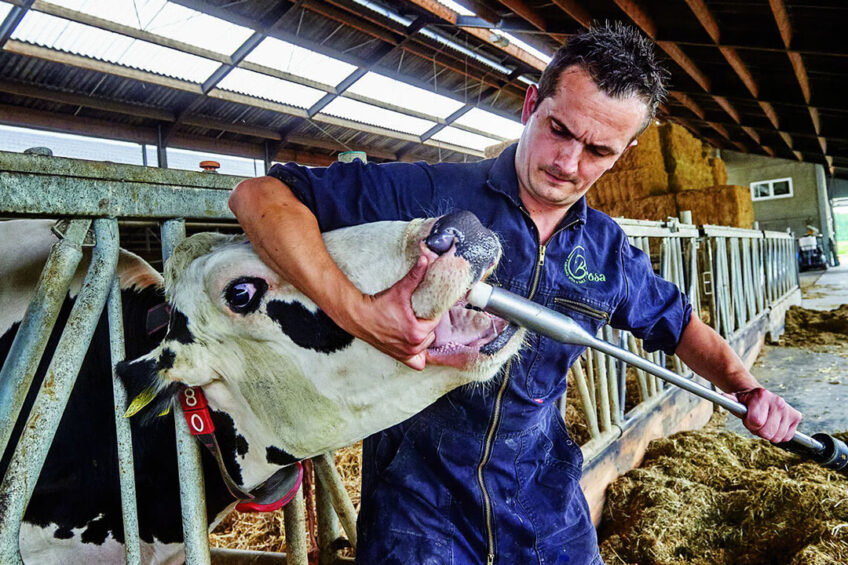New cheap bolus for smarter farming

As a part of smart farming solutions, a new bolus device helps dairy farmers ramp up production performance with only moderate investments. A group of scientists from the Institute of Microdevices and Control Systems, Russia, has developed the bolus which is cost effective at 25,000 roubles ($400) per unit.
During a series of trials, the intelligent farming system which focused primarily on monitoring gut health and feeding efficiency, showed an increase of milk gains which were on average 2-3 litres per cow. Like similar devices currently available on the market, the bolus developed by Russian scientists monitors pH levels, temperature, and hydration, etc. “Monitoring drinking is only a small part of the smart farm functionality and, of course, cannot give a full picture [of a cow’s health]. But this part clearly shows the usefulness of the bolus on a farm. For example, the system can detect when a cow drinks and creates an alert if it has only happened twice in the day, the normal level for a cow to drink is 5 to 6 times a day. [If only twice] by the evening, the cow will be dehydrated, which will reduce the morning milk yield,” says Vladimir Zhmylev, one of the authors of the study. “The system indicates when the animal does not drink enough – giving a reason for it to be checked,” he adds. The capsule is 140 mm in length, up to 40 mm in diameter and weighs just 250 grammes. It is easily swallowed by a cow and stays in the gut throughout its lifetime. The tool could be downsized to make it more versatile and economic.
New options
Blagodatnoe farm in the Khabarovsk region, Russia, is one of the first to utilise the new bolus technology. Like other farms in this part of the country, Blagodatnoe is struggling to make its dairy herd more effective. “Under our conditions, one cow provides 25 litres of milk. For our [Far Eastern] region, this is a good figure. However, the same animals in the central part of the country would give 50 litres of milk on a well-balanced feed,” says Oleg Borisov, chairman of Blagodatnoe. The company puts in a lot of effort to reach the level of European Russia, by taking advantage of new technologies. By using boluses, the management of Blagodatnoe hopes to figure out which factors help to boost milk gains. Also, in cooperation with local scientists, the farm launched an experiment which played classical music to cows during feeding. With the help of boluses, the company intends to track how various environmental factors such as classical music, change in lighting and temperature could impact the gastroenteric tract conditions. Some studies have shown that stress and relaxation could play an essential role in the gut health of cows, just like in humans. It is yet to be seen whether this is the case. However, some results from utilising the new boluses have already been seen. “The most important benefit is that cows no longer require daily inspections by a veterinarian,” Borisov says, adding that the boluses are integrated into an AI-based innovative farm system, which analyses data from a set of sensors in order to have the full picture of health for each cow. “Electronic passports for each cow and performance indicators for each employee are stored in the cloud. AI also distributes tasks for the day,” adds Borisov.
Smart approaches
High costs are believed to be the main factor preventing the use of boluses among dairy farmers. The cheapest imported non-invasive gut health monitoring technology was at least 35,000 roubles ($650) per unit in Russia. Currently, this figure is likely to be higher as the supply of new technologies from Western countries to Russia have dwindled in the wake of sanctions imposed by the European Union due to the war in Ukraine. These factors make gut health monitoring systems unaffordable for most Russian dairy farmers, especially given that the technology remains new, rather poorly explored, and there is little confidence whether the investment will eventually pay off. On the other hand, profitability in Russian milk farming remains low, and the payback period of new projects can be 15 to 20 years. This makes Russian milk farmers rather conservative. Most are cautious about embracing new technologies. Russian scientists, however, estimated that their bolus would be at least 20% cheaper compared to the imported technologies. Moreover, the scientists estimated that scaling up production could further lower the price for boluses. This could happen if smart farming becomes mainstream. So far, only a handful of farms across the country have invested in intelligent solutions. The scientists also believe that the boluses could provide the best results when used together with video surveillance and other sensors. They have already taught AI to cross-examine data collected from various sources to diagnose various health conditions of cows at early stages. “The data processing algorithm is based on continuous monitoring of a fairly large number of parameters: temperature, physical activity, heart murmurs, acidity. These parameters are collected in real-time, based on the developed mathematical models and the obtained dependencies. They make it possible to detect at an early stage a whole range of diseases and deviations in the diet,” concludes Dmitry Pavkin, one of the authors of the study.







